
Now Playing:
Mediterranean Sea 2019
Click here
for the 2019 Mediterranean Cruise Photo Gallery
8 November 2019 - En route Funchal, Madeira Island, Portugal to Ft. Lauderdale, Midway in a Seven-Day Nonstop Voyage
News Item: Since boarding the Konigsdam October 18, using Steps, an app, Jeanne calculated that we have walked 28.47 miles—daily average of 1.7. Some days felt like a forced march, as we walked through coastal Croatia, Montenegro, Slovenia, Sicily and the island nation of Malta.

A woman wearing a black jacket over a white blouse, wearing an employee name tag, stopped by our table at breakfast yesterday. “What do you do here,” I asked, surprised to see an employee woman among the sea (pun intended) of Indonesian waiters scurrying about taking and delivering breakfast orders. “I am an assistant dining room manager,” she said. “Wow, how interesting,” I retorted. In the 66 weeks (including two full, and one partial world cruise on the the MS Amsterdam, I had never encountered a woman working on the dining room floor of a Holland America ship, let alone in a leadership role. Jeanne and I had just met Laura del Carmen Perez Wong, from Lima, Peru. As she left us to check out other tables, I said: “I'd like to do an interview with you.” I made a call to our contact in the front office, and after lunch service, we sat down with La Perez.
“I only have half an hour,” were Laura's first words. “OK, how did you get here”, I began. “ I was 18, studying English, preparing to enter university—you needed at least one foreign language. I worked in restaurants to pay my way. At the same time, I had a friend who worked for another cruise line; he convinced me that I should apply; I did, and when I was 19, I was hired.” “OK, what jobs did you have on that line, and how did you get to Holland America?” “I began as an assistant waiter, then waiter, acting supervisor, food and beverage supervisor, head server, asst. dining room manager.” “So you came to Holland America as a parallel hire. Why did you do that?” “Holland America gave me more money.”
“Were you aware that you would be entering, not only an entire male world, but an entire Indonesian language world?” “Yes, an HR woman in Seattle interviewed me for this job, and made it clear that I would be a change agent.” “Has it been tough on you, working with the men you supervise?” “Sometimes, but they have their jobs to do and I have mine. The key for me is that I love what I do. The key for my guys and me is communication. I have two meetings a day with my crew. I have to doubly make certain that they get it, that we really understand each other.” During dinner service over a hundred waiters and assistants are working the two floors of the dining room. There are four assistant managers, each with a section of the floors. At dinner, Laura supervises 18 workers in the amazing logistical maze of efficient dinner service for 2453 passengers currently aboard the Konigsdam.
Laura has a 12 year old daughter, taken care of by her parents, and a younger brother still at home. “I send my salary home—I have no expenses aboard ship - food, lodging, uniforms, laundry, everything taken care of.” Laura made it clear that she provided much of everything for her family in Lima, rent, utilities, food money, as well as private school costs for her daughter's education. “After four years in my first job I was able to begin to pay for the education of my younger sister. She is now a lawyer. I'm very proud of that.”
10 November 2019 - Aboard the MS Konigsdam En Route Ft. Lauderdale, FL
Over the course of the last 13 years of Cruisin-thru-100 land and sea adventures, I have written snippets every other day. On this Holland America double-cruise (13 days making 10 ports of call in Adriatic and Mediterranean ports and 13 days getting back to the U.S., with a mere three port calls in Spain and Portugal), I have changed the format: I'll write a roundup of all the cities, islands, hamlets, and cathedrals Jeanne and I stared at and photographed.

Let's take it from the top.
Riding in the back of Air Canada planes Tampa to Toronto, hanging around the Toronto airport and a sleepless flight to Rome (food offer was chicken mush or pasta mush), beat us up. I now tell anyone interested that I'm closer to 90 in age, than 80. Sometimes is shows.
Dubrovnik, Croatia was our first port, after a day at sea. The big deal in the 7th Century walled city is to climb up very steep steps to the top of the wall and walk around. As we began the trudge to the top, my knees gave out first; Jeanne was a few steep steps ahead when her knees refused to move. Before we returned to a flat, cobble-stoned street, a stranger walking down saw me struggling and warned: “It is very, very strenuous.” Good advice, and down we came. We walked a spell through the jam-packed (whatever that means) streets, pondering the human immobility that summer must bring, had a beer and diet Coke at an outdoor cafe, and gratefully caught a shuttle bus back to the calm and comfort of our mother-ship.
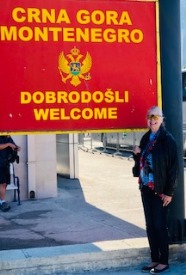
A Konigsdam overnight cruise and, bingo, we were in Montenegro, another Balkan nation, and a new one for me to check off—141—of my Traveler's Century Club list. Kotor is the seaport city where a lifeboat from the anchored Konigsdam dropped us off. Yes, dropped us into a city settled in 168 B.C—2187 years ago, when native American tribes were the only humans bouncing around North America. After the Romans, Montenegro was ruled for 400 years by Venice; it's modern history has been wrapped around Serbia. A Kotor port security guard clearly explained the relationship: “Same language, same culture, different countries”.
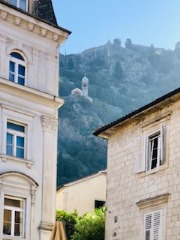
Jeanne and I spent much of our Kotor-time in, and around the Piazza of Arms, admiring the Roman Catholic and Orthodox churches. We marveled at one limestone church built high on the limestone mountains towering over Kotor. We saw the Venice-built fortress wall and photographed the ancient clock tower at the city's entrance. Then back to the dock and a pleasant motorboat ride to the Konigsdam.
Split, Croatia is a wonder to behold, a traveler's one of a kind, and it all goes back to a Roman emperor named Diocletian 245 AD to 316, born in Dalmatia (somewhere along the Adriatic coast). He was a clever, cunning Roman political operator, who disposed of his co-emperors and other opponents to become the number one Roman dude in AD 284 until he abdicated in 305. History teaches that he was the last Roman emperor who was into prosecuting Christians.
Now we know who Diocletian was, let's take a look at what he had constructed for his retirement home. On seven acres fronting the sea he built a palace complex: a fortress, his residential palace, another vast set of buildings housing his servants and army. Marble was imported from Greece and Italy, Egyptian columns and 12 sphinx were shipped in. Today, the Diocletian palace complex has 220 building and 3,000 residents. The cathedral (which Diocletian had built for his mausoleum) is one of the best-preserved ancient Roman structures still in tact anywhere. Jeanne and I walked over three miles exploring and photographing the cathedral and the Temple of Jupiter, now the baptistery, built as an ancient Roman temple; its original barrel-vaulted ceiling still there to behold. So there you have Diocletian's Palace, as best as my humble words can convey. The photos we came away with are much more adequate.
If it was Thursday October 24, it must have been Koper, Slovenia, and another new country to check off my TCC list. Our guide book describes Slovenia (a tiny chunk of the former Yugoslavia) as a hidden-gem of a country, with breathtaking interior scenery, and fine wines, but only 47 kilometers of coastline on the Adriatic Sea.
This is where Koper comes in. It is Slovenia's only modern, commercial port. Beyond the container ships hustle and bustle, is serene, auto-less Titov Square. At the south end is the partially Romanesque and Gothic 15th century white Praetorian Palace, now city hall. The Cathedral of the Assumption, with its over 100 foot high belfry—with 204 climbable steps: NO THANKS—dominates the square.
Jeanne and I spent part of a pleasant morning admiring and photographing the Cathedral and palace before returning to the Konigsdam for drinks. A side note: During our time in Titov Sq., a fellow Konigsdam passenger had a fainting spell, or other incident. When medical aid arrived, it did so on a motorcycle, blue emergency lights blazing, no siren.
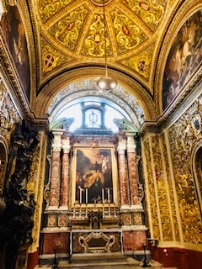
Malta, the small legendary, densely-populated island republic south of Sicily has been ruled by Carthaginians (8-7 centuries BC), Romans (beginning in 218 BC), the Knights of Malta took over in 1530, and lasted till Napoleon popped-in in 1798 for a couple of years. The British took over in 1800 and lasted, in one form or another, until 1979; the Brits home-ported their Mediterranean fleet in Malta, causing the island to be heavily bombed by Germany and Italy during WWII. Whew, what a history, but the more dramatic is yet to come: It is claimed the island was first settled around 3800 BC, making it in human terms older than the civilization of China, a head-shaker indeed. A fact not in doubt is that St. Paul shipwrecked on Malta shores in 60 AD, converted the populace to Roman Catholicism, and it remains the official religion to this day.
Valletta is named after Jean Parisot de la Valette, a Grand Master of the Knights of Malta; it became the Maltese capital in 1570. Valletta is where the Konigsdam docked on Monday, October 28, and where Jeanne and I wandered, particularly in and around St. John's Cathedral, the old fortress, and Upper Barrakka Gardens; the “upper” came into play when we payed a euro for an elevator ride from the waterfront up to the gardens, and into the city.
Elegant, of 16th century high baroque period architecture, St. John's Cathedral was constructed of Maltese limestone, and features a painting of the beheading of John the Baptist. Below the floors of St. John's are the tombs of 400 warrior knights. During our Valletta wanderings, we spotted a street sign pointing to St. Paul's “shipwreck” church, allegedly built on the spot where he came ashore, but we didn't have the strength for more exploration. Our total walking mileage for the day was over three. By the time we came upon the sign to the shipwreck church, our energy was draining quickly.
On our walk back to the docked Konigsdam, we walked past the Grandmaster's Palace, now the seat of the Maltese government.
Jeanne and I had long hoped to do at least an audit visit to fabled Malta; our walk-around Valletta and time in St. John's Cathedral did the trick. A minor benefit of our day in Valletta, Malta: another check-off on the Traveler's Century Club country list.
15 November 2019 - South Sarasota County, FL
While Split and Malta were our most profound and favorite ports of call, they were not the last. In fact, Jeanne and I were on two distinct 13 day cruises: the first one to investigate ports on the Adriatic and Mediterranean Seas, the second 13 days, again beginning in Civitavecchia (Rome), was to get the Konigsdam back to the Caribbean for the winter season, with two stops in Spain and one in Portugal, thrown in to sweeten the passenger pie before the seven straight sea days before docking in Ft. Lauderdale.
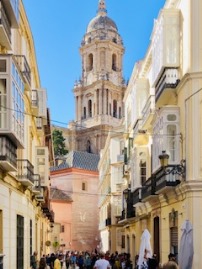
Our friend Hans Isler, a Rome resident, met us after we disembarked in Civitavecchia; he was responsible for the 44 days I spent aboard a Grimaldi cargo ship round-tripping N. Europe/ Angola West Africa, and a Mediterranean voyage Jeanne and I enjoyed on another Grimaldi freighter. It was off to the Lazio region, not far from Rome to roam around the 14th Century seaside fortress, the Castle of Santa Severa, and its attached maritime museum. After the adventure, we returned to Civitavecchia and La Nassa, a waterfront restaurant, for serious seafood and free-flowing conversation.
Cartagena, Spain was the principal supply port for the Republican government during the Spanish Civil War; thus, it was heavily bombed by German and Italian warplanes, as Hitler and Mussolini supported General Franco, leader of the Spanish rebellion. Jeanne and I delved into Cartagena and the civil war on an earlier visit; this time we walked around the city center, where local folks were dressed up to celebrate the early 1900s.
Malaga, Spain was founded by the Phoenicians in the 12 century BC; perhaps that doesn't make it older than sin, but it is old, baby, old. Malaga was invaded and ruled by Muslim arabs for 700 years, until Ferdinand II and Isabella I ran them off in 1487. Jeanne and I have visited Malaga, a charming city—particularly for an international port—many times. Pablo Picasso is a native son; our goal for this short sojourn was to visit his home town museum; alas, the lines were so long on a warm, sunny day we scuttled the plan.
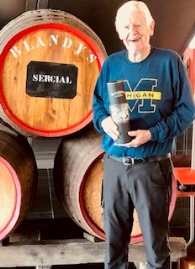
Funchal, on the island of Madeira, Portugal is famous for the production of Madeira—would you believe it—fortified wine. After a few sips in the Blandy tasting room, I bought a bottle of 10-year-aged. Madeira, my dear, was not our goal. For the last few Konigsdam stops Jeanne and I were seeking a tablecloth for our large dining table. “I have a few tablecloths, but they will not be large enough for your needs,” said a very pleasant, female fabric store clerk. “Perhaps, across the street,” she said pointing. Across the street we marched, and BINGO it was. We returned to the black and white stones (so typical of streets thoughout Portugal) of Funchal's principal boulevard, walked two long blocks, and climbed aboard a shuttle bus to the ship. On board, we enjoyed a light lunch, and Heineken beers (one without alohol) at the Dutch Cafe. “ Well, our latest European adventure is over,” I told Jeanne.
Wrapup of the wrapup: Our 26 days living aboard the Konigsdam were near-flawless. It seemed that a swarm of people were dedicated to making us comfortable and contented. We usually ate breakfast and dinner in the dining room (rather than the Lido informal food emporium, or the fee-added speciality restaurants). Service was efficient, good-natured, and the food tasty, occasionally a WOW—thinly shaved tuna and Spanish ham carpaccio appetizers—for example.
Our cabin stewards were attuned to our needs, and always cheerful, despite their heavy work loads. Entertainment was everywhere during the evening: the Konigsdam has venues devoted to hard-driving rock and roll; BB King-esque swinging blues; a string quartet+piano; twin piano players-singers provided pop music from various eras; a very high-tech, two level theatre featured rotating musical and comedy acts.
Constant summer-like weather was the great surprise of our late October-early November Ageanian and Mediterranean adventures.
Jeanne and I have returned to our sourth Sarasota Co. home with a new bucket of memories to join those of many travel years: during this Konigsdam voyage, our Holland America odometer spun to over 500 days and nights aboard HAL ships.
Recent Entries
- 2018 Italy
- 2016 World Cruise
- 2015 World Cruise
- Another Caribbean Christmas - 2013
- A South Pacific Adventure - 2013
- Historic Halifax, North Carolina - 2013
- Malaga to Miami - 2012
- Caribbean Getaway - 2012
- A Journey Down the Amazon - 2011
- A Hollywood Wedding and Hawaii - 2011
- Family Reunions - 2011
- A Carribean Christmas - 2010
- A Mini Mexico Cruise - 2010
- A Mammoth Asian Adventure - 2010
